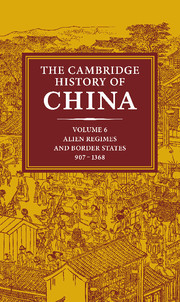Book contents
- Frontmatter
- Introduction
- 1 The Liao
- 2 The Hsi Hsia
- 3 The Chin dynasty
- 4 The rise of the Mongolian empire and Mongolian rule in north China
- 5 The reign of Khubilai khan
- 6 Mid-Yüan politics
- 7 Shun-ti and the end of Yüan rule in China
- 8 The Yüan government and society
- 9 Chinese society under Mongol rule, 1215–1368
- Bibliographical essays
- Bibliography
- Glossary-Index
- MAP 7. The Liao empire, ca. 1045
- MAP 12. The Hsi Hsia state, IIII
- Map 17. The Chin empire
- MAP 32. The Yüan empire">
- References
7 - Shun-ti and the end of Yüan rule in China
Published online by Cambridge University Press: 28 March 2008
- Frontmatter
- Introduction
- 1 The Liao
- 2 The Hsi Hsia
- 3 The Chin dynasty
- 4 The rise of the Mongolian empire and Mongolian rule in north China
- 5 The reign of Khubilai khan
- 6 Mid-Yüan politics
- 7 Shun-ti and the end of Yüan rule in China
- 8 The Yüan government and society
- 9 Chinese society under Mongol rule, 1215–1368
- Bibliographical essays
- Bibliography
- Glossary-Index
- MAP 7. The Liao empire, ca. 1045
- MAP 12. The Hsi Hsia state, IIII
- Map 17. The Chin empire
- MAP 32. The Yüan empire">
- References
Summary
YÜAN CHINA AT THE ACCESSION OF TOGHŌN TEMÜR (SHUN-TI)
When Toghōn Temür, barely thirteen years of age, was brought to the summer capital, Shang-tu, and installed there as the tenth emperor of the Yüan dynasty in July 1333, the realm he nominally headed had long been under stress, owing in part to complex, endemic tensions among its ruling elites and in part to troubles of long standing in China itself. Although there was no sign of imminent collapse, it is still a little ironic that of all the Yüan emperors, it was his reign, the last in China, that turned out to be the longest. It is not so ironic that as passive a ruler as he turned out to be, the whole quality of political life during his reign came to constitute a powerful negative example to the builders of the next dynasty, the Ming. Toghōn Temür (often referred to by his temple name, Shun-ti) reigned in China, or at least Ta-tu, until 1368. He died in Mongolia in 1370. The history of his reign raises the grand question, Why did the Yüan dynasty fall as and when it did? To that question there appears to be no simple answer. There was certainly no lack of energetic effort on the part of Mongols and Chinese alike to save it.
The younger emperor inherited a system of government whose size, complexity, and costliness stemmed both from its need to provide offices and employment for a large minortiy population of privileged Mongols and foreigners and from the fact that although the state was mainly a public bureaucracy, it was in part also the private patrimony of the imperial house and of certain high-ranking elites. A short description of these special features, as they had evolved by 1333, will serve to give some background to the march of events during Toghon Temiir's troubled reign.
Keywords
Information
- Type
- Chapter
- Information
- The Cambridge History of China , pp. 561 - 586Publisher: Cambridge University PressPrint publication year: 1994
References
Accessibility standard: Unknown
Why this information is here
This section outlines the accessibility features of this content - including support for screen readers, full keyboard navigation and high-contrast display options. This may not be relevant for you.Accessibility Information
- 9
- Cited by
